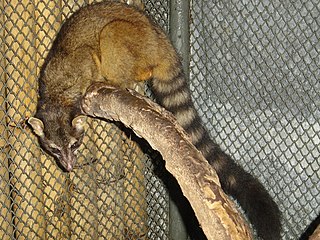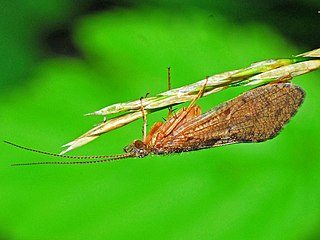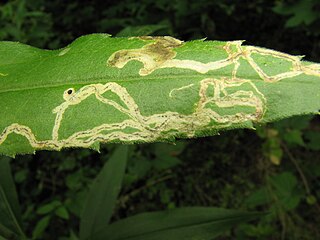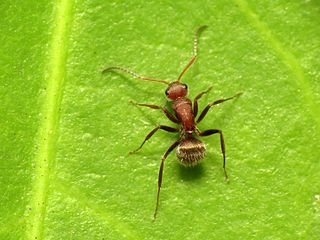
The cacomistle, also spelled cacomixtle, is a nocturnal, arboreal and omnivorous member of the carnivoran family Procyonidae. Its preferred habitats are wet, tropical, evergreen woodlands and mountain forests, though seasonally it will venture into drier deciduous forests.

The Braconidae are a family of parasitoid wasps. After the closely related Ichneumonidae, braconids make up the second-largest family in the order Hymenoptera, with about 17,000 recognized species and many thousands more undescribed. One analysis estimated a total between 30,000 and 50,000, and another provided a narrower estimate between 42,000 and 43,000 species.

Gracillariidae is an important family of insects in the order Lepidoptera and the principal family of leaf miners that includes several economic, horticultural or recently invasive pest species such as the horse-chestnut leaf miner, Cameraria ohridella.

Feliformia is a suborder within the order Carnivora consisting of "cat-like" carnivorans, including cats, hyenas, mongooses, viverrids, and related taxa. Feliformia stands in contrast to the other suborder of Carnivora, Caniformia.
The Catalogue of Life is an online database that provides an index of known species of animals, plants, fungi, and microorganisms. It was created in 2001 as a partnership between the global Species 2000 and the American Integrated Taxonomic Information System. The Catalogue is used by research scientists, citizen scientists, educators, and policy makers. The Catalogue is also used by the Biodiversity Heritage Library, the Barcode of Life Data System, Encyclopedia of Life, and the Global Biodiversity Information Facility. The Catalogue currently compiles data from 165 peer-reviewed taxonomic databases that are maintained by specialist institutions around the world. As of September 2022, the COL Checklist lists 2,067,951 of the world's 2.2m extant species known to taxonomists on the planet at present time.

Rhyacophila is a genus of caddisflies in the family Rhyacophilidae. There are at least 640 described species in Rhyacophila.

Lepicerus is a genus of myxophagan beetles containing three described species in the family Lepiceridae; it is the only extant genus in the family, with another genus, Lepiceratus only known from fossils. Extant species occur in the Neotropics, from Mexico south to Venezuela and Ecuador. Fossils referrable to the genus are known from the early Late Cretaceous of Southeast Asia.
Smicronyx is a genus of snout and bark beetles in the family Curculionidae. There are at least 70 described species in Smicronyx.

Liturgusa krattorum, also known as the Kratts' Lichen Mantis, is a species of mantis that was discovered by Gavin Svenson and the Cleveland Museum of Natural History. These species of mantis are mainly found in Peru. They live in tall trees, where they are preyed upon by predators such as birds and monkeys. The species themselves prey upon smaller insects, using their great speed in order to catch and kill prey. In a similar method to species such as cheetah, however ambush predator behaviors have been observed. The species was named after zoologists Martin Kratt and Chris Kratt, the hosts of Kratts' Creatures, Zoboomafoo, and Wild Kratts on PBS Kids, as well as Be the Creature on National Geographic. They are very small at a few centimetres long.

Phytomyza is a genus of leaf miner flies in the family Agromyzidae. At least 170 described species are placed in Phytomyza. The type species is Phytomyza flaveola, described by Carl Fallén in 1810.

Tettigoniidea is an infraorder of the order Orthoptera, with six extant families.

Pisciforma is a suborder of mayflies in the order Ephemeroptera. There are at least 410 described species in Pisciforma.

Gryllidea is an infraorder that includes crickets and similar insects in the order Orthoptera. There are two superfamilies, and more than 6,000 described species in Gryllidea.

Hydropsyche is a genus of netspinning caddisflies in the family Hydropsychidae. There are at least 260 described species in the genus Hydropsyche.

Camponotus planatus, known generally as the compact carpenter ant or short carpenter ant, is one of three Camponotus species that is polygynous, or has more than one queen. It is a species of ant in the family Formicidae.

Tropiduchidae is a family of planthoppers in the order Hemiptera. There are at least 160 genera and 600 described species in Tropiduchidae.

Limnichidae, commonly called minute marsh-loving beetles, is a family of beetles belonging to Byrrhoidea. There are at least 30 genera and 350 described species in Limnichidae. They are found worldwide, with the greatest diversity in tropical regions. Most species seem to be associated with water-adjacent habitats, such as riparian and coastal locations, though many species are likely fully terrestrial, with some species being associated with leaf litter and arboreal habitats. Species with known diets feed on moss or algae. The oldest fossils of the family are known from mid-Cretaceous Burmese amber from Myanmar.

Liturgusa is the type genus of praying mantises of the family Liturgusidae. The genus consists of more than twenty species with a Neotropical distribution.
Richard Herbert Foote was an American entomologist who specialized in the taxonomy of fruit flies. The Handbook of the Fruit Flies of America North of Mexico published in 1993 was a major work. He was a promoter of the use of information technology for the cataloguing of insect species.


















